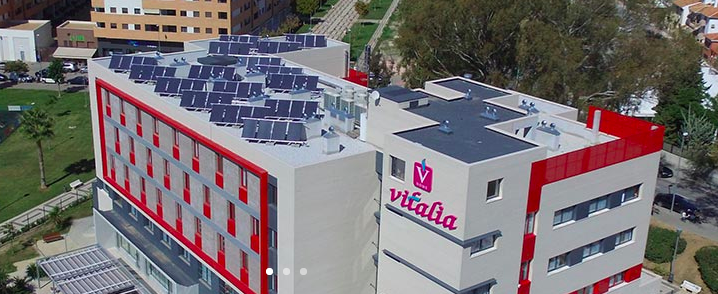Posted: November 18, 2018

Photo: Abora
Local production of PVT panels and systems which achieve high solar fractions by using seasonal storage: This is the main objective of Spanish start-up company Abora, based in Saragossa. It has already installed several hot water PVT systems at multi-family houses, sports centres and nursing homes and a combined heating and cooling unit at a hotel in Gerona in the northeast of Spain. Four more installations are in the pipeline and each consists of a PVT system, seasonal storage and a heat pump. Abora participates in Task 60, Application of PVT Collectors, a research platform set up under the aegis of the IEA Solar Heating and Cooling programme. The photo shows 64 PVT collectors providing heat and electricity for 162 people in a home for the elderly in Málaga.
“As a start-up, we are taking part in Task 60 to learn about PVT market development in other countries and let third-party experts analyse our monitored systems,” Alejandro del Amo, the company’s CEO, said. Abora was founded in the summer of 2017 after raising EUR 2 million of capital and five years of previous experiences in manufacturing PVT panels. The company has a permanent staff of 20 people, of which about 50 % are in charge of PVT collector manufacturing. Production output in 2018 is around 1,200 panels. The company, which concentrates on commercial clients, such as hotels, hospitals, nursing homes and industrial facilities, expects sales to grow to 2,500 units in 2019.
Additional cover to increase efficiency
Abora manufactures glazed PVT panels, which consist of monocrystalline cells that are laminated together with a copper absorber. The absorber has a selective Tinox coating because a small portion of irradiation penetrate the PV cells and reach the absorber surface.
To increase efficiency, the hybrid components feature the use of an inert gas between the PV cells and the glass cover, as well as some treatments, to decrease reflection and heat loss (from convection, conduction and radiation). The PVT parts have also been insulated on the back.
Del Amo said: “Thanks to this innovative device, we can achieve payback periods of between 5 and 6 years without incentives. This means that our solutions are not only suited for new, larger residential buildings but also existing ones, where users usually require measures with a fast return on investment.”
|
|
PVT system
|
|
|
aH60
|
aH72
|
|
Gross area
|
1.65 m2
|
1.96 m2
|
|
Weight
|
43 kg
|
50 kg
|
|
Photovoltaic peak power
|
260 Wp
|
300 Wp
|
|
Collector efficiency
|
0.59
|
0.59
|
|
Stagnation temperature
|
155 °C
|
150 °C
|
|
No. of hydraulic connections
|
4
|
4
|
Technical features of Abora´s hybrid panels, tested at CENER in Spain. Solar Keymark certification is in the works and will most likely be issued in early 2019.
Source: Abora
Be ambitious and store solar heat for winter
One key approach to fulfil Abora’s vision for the market is to be more ambitious when it comes to the role of solar heat: In a typical residential building in Spain, occupants need 80 % of total heat demand for space heating and only 20 % for domestic hot water. “When you look at national building regulations, which set a 50 % renewable heat requirement for hot water use, solar covers only 10 % of all thermal needs,” said del Amo.
It was the main reason behind the company’s decision to offer solutions with seasonal heat storage, which allows for higher solar fractions and provides heat in buildings such as schools, where consumption is low in summer.
The company’s strategy for the market lists seasonal storage as a plus also for those customers who are not focused that much on maximising profitability but rather on meeting nearly all of their needs by renewable energy.
Innovative projects in the pipeline
A seasonal buffer storage tank will be one key feature in four projects which are already in the pipeline and will be developed by Abora over the next two or three years: Two of them will be carried out in Saragossa – at the British School and the local university’s faculty of philosophy. The third will supply energy for a sports centre in the region of Catalonia and the last is going to be installed at the Tobazo Hotel close to the French border.
Another plan worth mentioning is a three-phase project developed for a business producing prefabricated houses. During the first phase, 112 PVT collectors will be installed to provide thermal energy for a radiant heating system at company offices. Next summer, they will also be connected to a 30 kW adsorption chiller, which will meet part of the cooling needs. During the third phase, waste heat produced by the chiller will be transferred to a heat pump to raise the temperature from 30 °C to 60 °C and heat a thermal storage system.
A sunny future
Del Amo expects growing demand for PVT technologies in Spain, as taxes on self-consumed solar electricity were abolished in October 2018. A new law also makes for an easy and demand-based exchange of surplus electricity between multi-family houses and adjacent energy consumers. Solar suppliers are now waiting for the government to establish comprehensive regulation.
The article was written by Riccardo Battisti, a solar thermal consultant and market researcher working at Ambiente Italia (Rome, Italy).
Websites of organisations mentioned in this article: